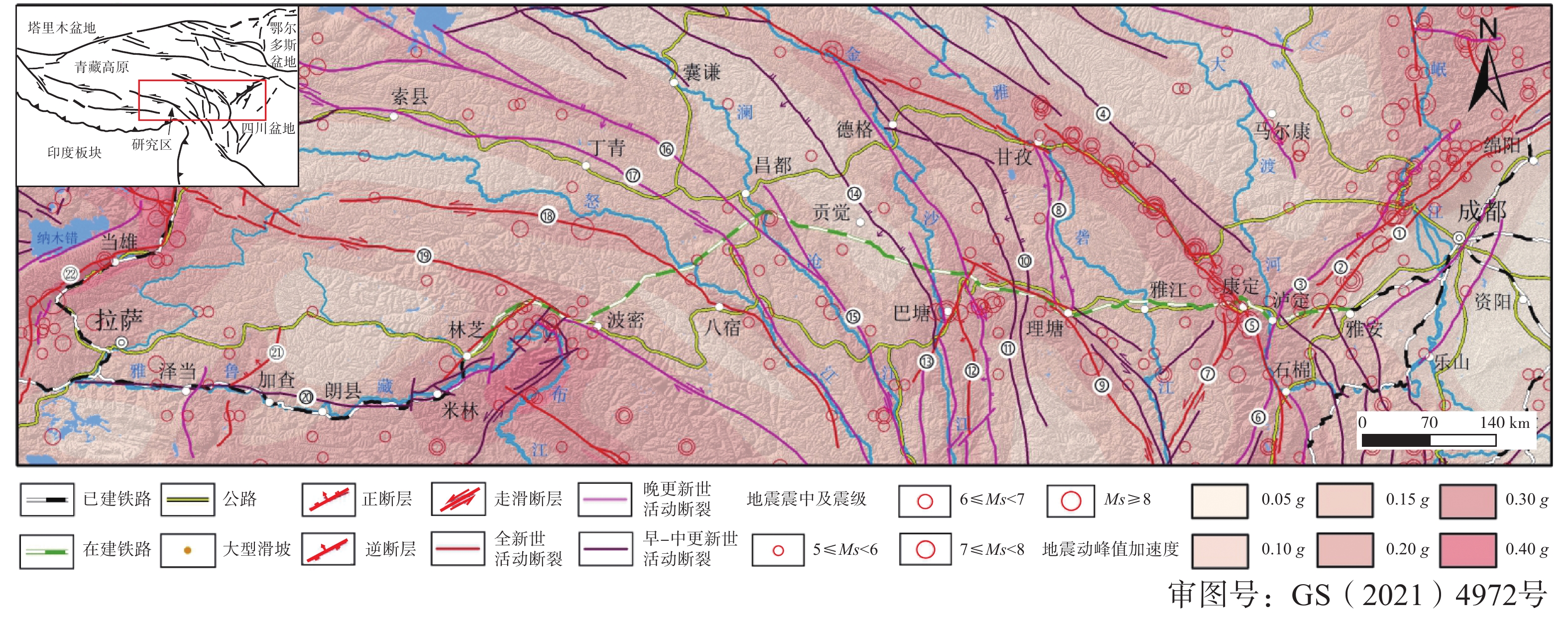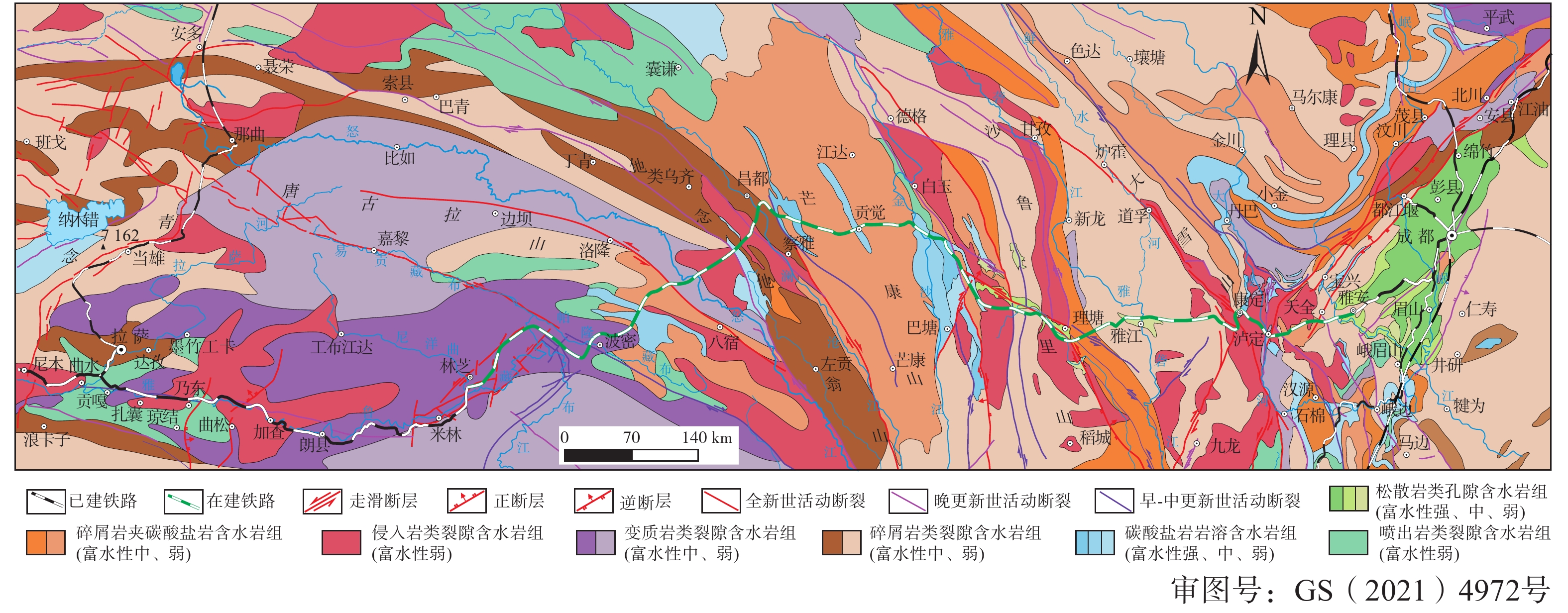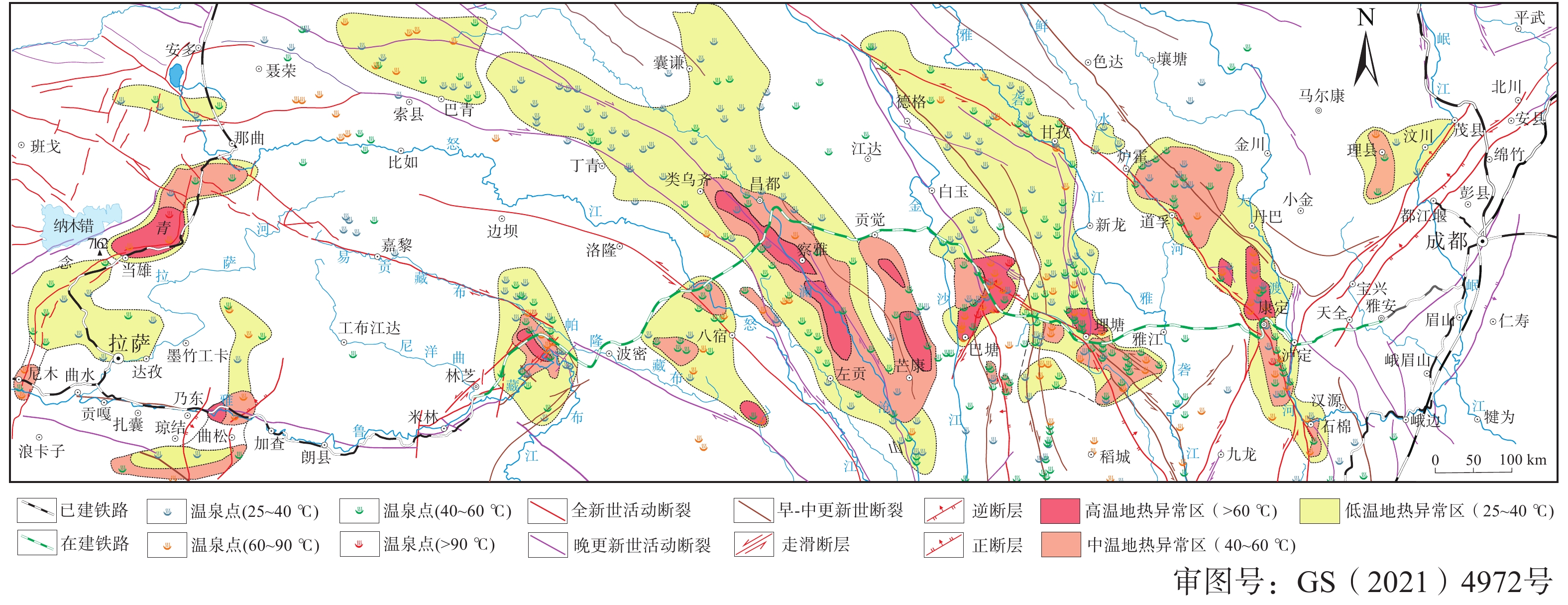Key problems on hydro-engineering-environmental geology along the Sichuan-Xizang Railway corridor: Current status and development direction
-
摘要:
川藏铁路是我国正在建设的世纪工程,复杂的地质演化史导致铁路廊道地质环境差异大,水文地质、工程地质和环境地质问题复杂多变,在工程施工及今后运营中值得高度关注。在简要回顾川藏铁路廊道以往地质工作的基础上,阐述了铁路建设面临的水工环地质问题,包括高原构造岩溶高压突涌水、断裂带基岩裂隙高压突水突泥、高温热水热害等水文地质问题,活动断裂断错与强震灾害、高地应力与深埋隧道岩爆和大变形、特殊岩土体的不良工程特性与灾害效应、高位远程滑坡灾害链等工程地质问题,含煤地层和热液矿床酸性水腐蚀性、湿地生态退化演替、铁路建设与敏感生态环境的互馈效应等环境地质问题。提出了今后值得深入研究的关键科学技术问题:水文地质方面包括高原岩溶发育层序规律与构造岩溶蓄水构造类型、深埋隧道突水突泥的孕灾致灾模式与预测方法、活动断裂控热机制与地下热水循环模式、高温热害风险识别及地热资源化技术等问题;工程地质与地质灾害方面包括活动断裂的精细特征与工程断错效应、复杂地质构造区深部构造应力场特征、构造混杂岩带工程地质特性与灾害效应、水-力-热多场耦合作用下深埋隧道围岩稳定性与灾害效应、内外动力耦合作用下的高位远程滑坡机理及风险防控技术等问题;环境地质方面包括高原多源水转化循环机制与生态脆弱区生态需水量控制技术、隧道建设的水文生态环境效应、生态地质环境监测评价与保护关键技术、全球气候变暖的地质生态环境效应等问题。从公益性地质调查和商业性工程勘察相结合的角度,提出了地质调查是基础、科技攻关是关键、灾害隐患监测与工程治理协调推进的应对策略,为国家重大工程规划区的水工环地质工作发展方向提供了参考建议。
Abstract:The Sichuan-Xizang Railway is a century project under construction. The complex geological evolution history has led to large differences in geo-environmental conditions along the railway. Hydrogeological, engineering geological, and environmental geological problems are complex and changeable, which deserves great attention in engineering construction and future operations. Based on a brief review of the past geological work on the Sichuan-Xizang Railway corridor, the hydro-engineering-environmental geological problems that may be faced during the railway construction have been described. The hydrogeological problems include 1) high-pressure water inrush from plateau tectonic karst, 2) high-pressure water inrush and mud outburst from faulted bedrock fissures, 3) high-temperature hot water thermal damage. The engineering geological problems include 1) active faults and strong earthquake disasters, 2) high in-situ stress and rock burst or large deformation in deep tunnel, 3) problem rocks or soils and their disaster effects, 4) high-position landslide disaster chain. The environmental geological problems include 1) acidic water corrosiveness from coal-bearing strata and hydrothermal deposits, 2) wetland ecological degradation, 3) interaction effects between the railway construction and the sensitive ecological environment. In the meanwhile, key scientific and technological issues, which should be deeply studied in the future, are put forward. In terms of hydrogeology, such as 1) sequence law of plateau karst development and types of tectonic karst water storage structures, 2) disaster-generating models and prediction methods of water and mud bursts in deep-buried tunnels, 3) active fault control mechanisms and geothermal water circulation models, 4) identification of high-temperature heat hazard risk and geothermal resources utilization technology. In terms of engineering geology and geohazard, such as 1) investigation of fine features of active faults and related engineering fault effects, 2) development features of deep tectonic stress fields in complex geological structures, 3) engineering geological properties of tectonic mélange belts and related disaster effects, 4) surrounding rock stability and disaster effects of deep-buried tunnel under water-mechanical-thermal multi-field coupling condition, 5) mechanisms of high-position run-out landslide and risk control technology under internal and external dynamic coupling. In terms of environmental geology, such as 1) mechanisms of plateau multi-source water conversion cycle and the technology of ecological water demand control in the ecologically fragile area, 2) hydro-ecological environmental effect of tunnel construction, 3) key technology of ecological geological environment monitoring, evaluation and protection, 4) geo-ecological environmental effect of global climate warming, etc. From the view of combining non-profit geological surveys and commercial engineering surveys, a response strategy has been proposed that geological surveys are the foundation, scientific and technological research is the key, and the monitoring of potential hazards and engineering control should be promoted, which provides suggestions on developing direction for hydro-engineering-environmental geology work on major project planning areas.
-
Key words:
- Sichuan-Xizang Railway /
- hydrogeology /
- engineering geology /
- environmental geology /
- geohazard
-

-
表 1 八宿-然乌一带盐类沉淀物矿物成分及工程评价
Table 1. Mineral composition and engineering evaluation of salt deposits in Basu-Ranwu region
沉积物特征 XRD法矿物成分鉴定 1∶10水提取液 工程评价 盐类矿物 非盐类矿物 颜色 pH值 
易溶盐 溶解性 腐蚀性 盐胀性 煤系地层白色松软絮状物 泻盐、石膏 石英、伊利石、高岭石 无色 8.32 13.91 23.96 强 强 强 黄绿色皮壳状、瘤状沉淀物 镁叶绿矾、叶绿矾 石英 玫瑰红 2.06 35.78 69.98 强 强 − 硫化矿氧化带灰白色絮状物 泻盐、石膏 石英、伊利石、高岭石 无色 4.25 22.74 35.97 强 强 强 灰绿色半硬质瘤状物 镁叶绿矾、石膏、叶绿矾 石英 玫瑰红 2.20 29.56 59.83 强 强 强 注:(1)  含量采用BaSO4重量法测定;(2)
含量采用BaSO4重量法测定;(2) 和易溶盐的单位为g/100 g;(3)工程评价中溶解性大小依据1∶10水提液含盐量(g/100 g),腐蚀性评价依据国家标准(GB 50021—2001)土中
和易溶盐的单位为g/100 g;(3)工程评价中溶解性大小依据1∶10水提液含盐量(g/100 g),腐蚀性评价依据国家标准(GB 50021—2001)土中 含量和pH值大小,盐胀性主要根据盐类矿物结晶水数量判别。
含量和pH值大小,盐胀性主要根据盐类矿物结晶水数量判别。 -
[1] LU C F, CAI C X. Challenges and countermeasures for construction safety during the Sichuan-Xizang Railway Project[J]. Engineering,2019,5(5):833 − 838. doi: 10.1016/j.eng.2019.06.007
[2] 崔鹏, 苏凤环, 邹强, 等. 青藏高原山地灾害和气象灾害风险评估与减灾对策[J]. 科学通报,2015,60(32):3067 − 3077. [CUI Peng, SU Fenghuan, ZOU Qiang, et al. Risk assessment and disaster reduction strategies for mountainous and meteorological hazards in Xizang Plateau[J]. Chinese Science Bulletin,2015,60(32):3067 − 3077. (in Chinese with English abstract) doi: 10.1360/N972015-00849
[3] 彭建兵, 崔鹏, 庄建琦. 川藏铁路对工程地质提出的挑战[J]. 岩石力学与工程学报,2020,39(12):2377 − 2389. [PENG Jianbing, CUI Peng, ZHUANG Jianqi. Challenges to engineering geology of Sichuan-Xizang Railway[J]. Chinese Journal of Rock Mechanics and Engineering,2020,39(12):2377 − 2389. (in Chinese with English abstract)
[4] 殷跃平, 王文沛. 高位远程滑坡动力侵蚀犁切计算模型研究[J]. 岩石力学与工程学报,2020,39(8):1513 − 1521. [YIN Yueping, WANG Wenpei. A dynamic erosion plowing model of long run-out landslides initialized at high locations[J]. Chinese Journal of Rock Mechanics and Engineering,2020,39(8):1513 − 1521. (in Chinese with English abstract)
[5] 卓宝熙. 遥感技术在工程建设中的实践与认识[M]. 北京: 中国铁道出版社, 2012.
ZHUO Baoxi. Practice and understanding of remote sensing technology in engineering construction[M]. Beijing: China Railway Publishing House, 2012. (in Chinese)
[6] 潘桂棠, 王立全, 张万平, 等. 青藏高原及邻区大地构造图及说明书[M]. 北京: 地质出版社, 2013.
PAN Guitang, WANG Liquan, ZHANG Wanping, et al. Geotectonic map and instruction of the Qinghai-Xizang Plateau and adjacent areas[M]. Beijing: Geological Publishing House, 2004. (in Chinese)
[7] 林化岭. 四川省康定—宝兴地区1/50万区域水文地质普查报告[R]. 中国人民解放军00931部队, 1980.
LIN Hualing. 1/500000 regional hydrogeological survey report of Kangding-Baoxing area, Sichuan Province[R]. 00931 Unit of the Chinese People’s Liberation Army, 1980. (in Chinese)
[8] 刘益栋. 甘孜县-炉霍地区1/50万区域水文地质普查报告[R]. 中国人民解放军00931部队, 1983.
LIU Yidong. 1/500000 regional hydrogeological survey report of Ganzi County-Luhuo area[R]. 00931 Unit of the Chinese People’s Liberation Army, 1983. (in Chinese)
[9] 李前良. 理塘-义敦地区1/50万区域水文地质普查报告[R]. 中国人民解放军00931部队, 1983.
LI Qianliang. 1/500000 regional hydrogeological survey report of Litang-Yidun area[R]. 00931 Unit of the Chinese People’s Liberation Army, 1983. (in Chinese)
[10] 李云贵, 唐波, 郭玉清, 等. 昌都幅(H-47)1/100万区域水文地质普查报告[R]. 眉山: 地矿部915水文工程地质队, 1987.
LI Yungui, TANG Bo, GUO Yuqing, et al. 1/1000000 regional hydrogeological survey report of Chamdo Sheet(H-47)[R]. Meishan: 915 Hydrological Engineering Geology Team, Ministry of Geology and Mineral Resources, 1987. (in Chinese)
[11] 李云贵, 王作堂, 徐贵键. 拉萨幅(8-46)1/100万区域水文地质普查报告[R]. 眉山: 地矿部915水文工程地质队, 1990.
LI Yungui, WANG Zuotang, XU Guijian. 1/1000000 regional hydrogeological survey report of Lhasa Sheet (8-46)[R]. Meishan: 915 Hydrological Engineering Geology Team, Ministry of Geology and Mineral Resources, 1990. (in Chinese)
[12] 崔之久. 青藏高原的古岩溶[J]. 自然杂志,1979,1(9):24 − 25. [CUI Zhijiu. Ancient karst in the Qinghai-Xizang Plateau[J]. Nature Magazine,1979,1(9):24 − 25. (in Chinese)
[13] 朱学稳. 峰林喀斯特的性质及其发育和演化的新思考(2)[J]. 中国岩溶,1991,10(2):137 − 150. [ZHU Xuewen. New considerations on the characteristics and evolution of the Fenglin karst (the second continuance)[J]. Carsologica Sinica,1991,10(2):137 − 150. (in Chinese with English abstract)
[14] 张之淦. 岩溶发生学——理论探索[M]. 桂林: 广西师范大学出版社, 2006.
ZHANG Zhigan. Origin of karst: theoretical works on karst[M]. Guilin: Guangxi Normal University Press, 2006. (in Chinese)
[15] 张恒, 刘宗祥. 川西地区深部水文地质调查报告[R]. 贵阳: 贵州省地质环境监测总站, 2017.
ZHANG Heng, LIU Zongxiang. Deep hydrogeological survey report in Western Sichuan Region[R]. Guiyang: Guizhou Geological Environment Monitoring Institute, 2017. (in Chinese)
[16] 李晓, 王金金, 黄珣, 等. 鲜水河断裂带康定至道孚段热水化学与同位素特征[J]. 成都理工大学学报(自然科学版),2018,45(6):733 − 745. [LI Xiao, WANG Jinjin, HUANG Xun, et al. Chemical and isotopic characteristics of hot water in the Kangding—Daofu section of Xianshuihe fault zone, Sichuan, China[J]. Journal of Chengdu University of Technology (Science & Technology Edition),2018,45(6):733 − 745. (in Chinese with English abstract)
[17] 张春潮, 李向全, 马剑飞, 等. 基于水化学及稳定同位素的西藏察雅地下热水成因研究[J]. 现代地质,2021,35(1):199 − 208. [ZHANG Chunchao, LI Xiangquan, MA Jianfei, et al. Formation model of geothermal water in Chaya of Xizang: Perspective from hydrochemistry and stable isotopes[J]. Geoscience,2021,35(1):199 − 208. (in Chinese with English abstract)
[18] 李媛, 孟晖, 董颖, 等. 中国地质灾害类型及其特征—基于全国县市地质灾害调查成果分析[J]. 中国地质灾害与防治学报,2004,15(2):29 − 34. [LI Yuan, MENG Hui, DONG Ying, et al. Main types and characteristics of geo-hazard in China:Based on the results of geo-hazard survey in 290 counties[J]. The Chinese Journal of Geological Hazard and Control,2004,15(2):29 − 34. (in Chinese with English abstract) doi: 10.3969/j.issn.1003-8035.2004.02.005
[19] 赵留辉. 川藏铁路昌都至林芝段对地下水环境的影响及对策[J]. 铁道建筑,2020,60(10):155 − 158. [ZHAO Liuhui. Influence of Changdu-Linzhi section in Sichuan-Xizang Railway on groundwater environment and countermeasures[J]. Railway Engineering,2020,60(10):155 − 158. (in Chinese with English abstract)
[20] 郭长宝, 张永双, 杨志华, 等. 川藏铁路沿线活动断裂与地质灾害效应调查研究[M]. 北京: 地质出版社, 2018.
GUO Changbao, ZHANG Yongshuang, YANG Zhihua, et al. Investigation and research on the active faults along the Sichuan-Xizang Railway and geological disaster[M]. Beijing: Geological Publishing House, 2018. (in Chinese)
[21] 王栋, 李天斌, 蒋良文, 等. 川藏铁路某超深埋隧道地应力特征及岩爆分析[J]. 铁道工程学报,2017,34(4):46 − 50. [WANG Dong, LI Tianbin, JIANG Liangwen, et al. Analysis of the stress characteristics and rock burst of ultra-deep buried tunnel in Sichuan-Xizang Railway[J]. Journal of Railway Engineering Society,2017,34(4):46 − 50. (in Chinese with English abstract) doi: 10.3969/j.issn.1006-2106.2017.04.010
[22] 何平, 张广泽, 强新刚. 川藏线桑珠岭隧道地下热水成因及选线研究[J]. 铁道工程学报,2020,37(6):10 − 13. [HE Ping, ZHANG Guangze, QIANG Xingang. Cause analysis of geothermal water and geological route selection research on the Sangzhuling tunnel of Sichuan-Xizang Railway[J]. Journal of Railway Engineering Society,2020,37(6):10 − 13. (in Chinese with English abstract) doi: 10.3969/j.issn.1006-2106.2020.06.003
[23] 潘桂棠, 任飞, 尹福光, 等. 洋板块地质与川藏铁路工程地质关键区带[J]. 地球科学,2020,45(7):2293 − 2304. [PAN Guitang, REN Fei, YIN Fuguang, et al. Key zones of Oceanic Plate geology and Sichuan-Xizang Railway Project[J]. Earth Science,2020,45(7):2293 − 2304.
[24] 郭长宝, 吴瑞安, 蒋良文, 等. 川藏铁路雅安—林芝段典型地质灾害与工程地质问题[J]. 现代地质,2021,35(1):1 − 17. [GUO Changbao, WU Rui’an, JIANG Liangwen, et al. Typical geohazards and engineering geological problems along the Ya’an-Linzhi section of the Sichuan-Xizang Railway, China[J]. Geoscience,2021,35(1):1 − 17. (in Chinese with English abstract)
[25] 潘家伟, 李海兵, CHEVALIER Marie-Luce, 等. 鲜水河断裂带色拉哈—康定段新发现的活动断层: 木格措南断裂[J]. 地质学报,2020,94(11):3178 − 3188. [PAN Jiawei, LI Haibing, CHEVALIER M L, et al. A newly discovered active fault on the Selaha-Kangding segment along the SE Xianshuihe fault: the South Mugecuo fault[J]. Acta Geologica Sinica,2020,94(11):3178 − 3188. (in Chinese with English abstract) doi: 10.3969/j.issn.0001-5717.2020.11.002
[26] ZHANG Y S, YAO X, YU K, et al. Late-Quaternary slip rate and seismic activity of the Xianshuihe fault zone in southwest China[J]. Acta Geologica Sinica (English Edition),2016,90(2):525 − 536. doi: 10.1111/1755-6724.12688
[27] MENG W, GUO C B, ZHANG Y S, et al. In situ stress measurements in the Lhasa terrane, Xizang Plateau, China[J]. Acta Geologica Sinica (English Edition),2016,90(6):2022 − 2035. doi: 10.1111/1755-6724.13019
[28] 任洋, 王栋, 李天斌, 等. 川藏铁路雅安至新都桥段地应力特征及工程效应分析[J]. 岩石力学与工程学报,2021,40(1):65 − 76. [REN Yang, WANG Dong, LI Tianbin, et al. In-situ geostress characteristics and engineering effect in Ya’an−Xinduqiao section of Sichuan−Xizang Railway[J]. Chinese Journal of Rock Mechanics and Engineering,2021,40(1):65 − 76. (in Chinese with English abstract)
[29] ZHANG Y S, GUO C B, QU Y X, et al. Engineering geological properties of altered rocks and implications for railway construction in the Sanjiang orogenic belt, Southwest China[J]. Bulletin of Engineering Geology and the Environment,2011,70(1):143 − 152. doi: 10.1007/s10064-010-0294-y
[30] 程谦恭, 王玉峰, 朱圻, 等. 高速远程滑坡超前冲击气浪动力学机理[J]. 山地学报,2011,29(1):70 − 80. [CHENG Qiangong, WANG Yufeng, ZHU Qi, et al. Dynamics of the airblasts generated by rock avalanches[J]. Journal of Mountain Science,2011,29(1):70 − 80. (in Chinese with English abstract) doi: 10.3969/j.issn.1008-2786.2011.01.011
[31] 张永双, 杜国梁, 郭长宝, 等. 川藏交通廊道典型高位滑坡地质力学模式[J]. 地质学报,2021,95(3):605 − 617. [ZHANG Yongshuang, DU Guoliang, GUO Changbao, et al. Research on typical geomechanical model of high-position landslides on the Sichuan-Xizang traffic corridor[J]. Acta Geologica Sinica,2021,95(3):605 − 617. (in Chinese with English abstract) doi: 10.3969/j.issn.0001-5717.2021.03.001
[32] 殷跃平. 西藏波密易贡高速巨型滑坡特征及减灾研究[J]. 水文地质工程地质,2000,27(4):8 − 11. [YIN Yueping. Rapid huge landslide and hazard reduction of Yigong River in the Bomi, Xizang[J]. Hydrogeology & Engineering Geology,2000,27(4):8 − 11. (in Chinese with English abstract) doi: 10.3969/j.issn.1000-3665.2000.04.003
[33] GUO C B, MONTGOMERY D R, ZHANG Y S, et al. Evidence for repeated failure of the giant Yigong landslide on the edge of the Xizang Plateau[J]. Scientific Reports,2020,10(1):1 − 7. doi: 10.1038/s41598-019-56847-4
[34] 王立朝, 温铭生, 冯振, 等. 中国西藏金沙江白格滑坡灾害研究[J]. 中国地质灾害与防治学报,2019,30(1):1 − 9. [WANG Lichao, WEN Mingsheng, FENG Zhen, et al. Researches on the Baige landslide at Jinshajiang River, Xizang, China[J]. The Chinese Journal of Geological Hazard and Control,2019,30(1):1 − 9. (in Chinese with English abstract)
[35] 张永双, 胡道功, 吴中海, 等. 滇藏铁路沿线地壳稳定性及重大工程地质问题[M]. 北京: 地质出版社, 2009.
ZHANG Yongshuang, HU Daogong, WU Zhonghai, et al. Crustal stability and major engineering geological problems along the Yunnan-Xizang Railway[M]. Beijing: Geological Publishing House, 2009. (in Chinese)
[36] 吕玉香, 蒋勇军, 王正雄, 等. 西南岩溶槽谷区隧道建设的水文生态环境效应研究进展[J]. 生态学报,2020,40(6):1851 − 1864. [LÜ Yuxiang, JIANG Yongjun, WANG Zhengxiong, et al. Review on the hydrology and the ecological and environmental effects of tunnel construction in the karst valley of Southwest China[J]. Acta Ecologica Sinica,2020,40(6):1851 − 1864. (in Chinese with English abstract)
[37] 许佑顶, 姚令侃. 川藏铁路沿线特殊环境地质问题的认识与思考[J]. 铁道工程学报,2017,34(1):1 − 5. [XU Youding, YAO Lingkan. Some cognitions and thinkings about the specific geo-environmental problems along the Sichuan-Xizang Railway[J]. Journal of Railway Engineering Society,2017,34(1):1 − 5. (in Chinese with English abstract) doi: 10.3969/j.issn.1006-2106.2017.01.001
-




 下载:
下载:



